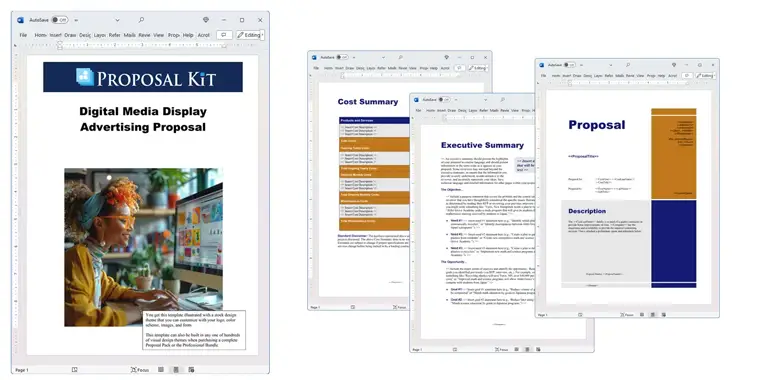How to write your Digital Media Display Advertising Proposal
We include this 18 page layout with every Proposal Pack. If you want this template to have a different visual design theme than the one illustrated here, purchase any Proposal Pack design and create this template using the purchased design theme. This template is included in every Proposal Pack. If you get a Proposal Pack or the Professional Bundle, you can also make any variation of this template with different chapters to suit your needs.
We typically include more chapters in the templates than most people will need to give everyone more variety in the chapters they may need. You can trim down a long template by removing pages you do not need or combining multiple chapter topics into one page.
 DOWNLOADABLE, ONE-TIME COST, NO SUBSCRIPTION FEES
DOWNLOADABLE, ONE-TIME COST, NO SUBSCRIPTION FEES If you need this template on DVD media order from our Amazon shop.
If you need this template on DVD media order from our Amazon shop.
You can also create countless variations of this document to suit your needs using the included library of 2200+ chapters if ordering a Proposal Pack or Pro Bundle.
 What Our Clients Say
What Our Clients SayWorth the extra cost to have both products to sell you product! Easy to use, great presentation! You will make your money back! I’ve been using this product since 2012 and always upgrade for the latest version! I recommend the Proposal Pack Wizard as well!"
One All Tennis Association
Related Article
Related Video
Related Templates
- Digital Signage Provider Proposal
- Marketing Campaign Services Proposal (Long)
- Marketing Plan
- Advertising Campaign Services Proposal
- Media Campaign Advertising Pitch Proposal
- Marketing Campaign Services Proposal (Short)
- Digital Marketing Agency Proposal Template
- Digital Marketing Proposal Template
- Digital Sales Room Proposal Template
- Google Ads And PPC Proposal Template
- Talent Agency Services Proposal
- SEO Services for Voice Search Proposal
- SEO Services Proposal (Short)
- Company Rebranding Proposal
- Advertising Proposal Template
- Brand Ambassador Proposal Template
- Advertising and Marketing Agency Proposal Template
- Advertising Sales Proposal Template
- Affiliate Marketing Proposal Template
- Voiceover Recording Services Proposal and Contract
- Agency Proposal Template
- Website Advertising Offer Proposal
- Marketing Services Proposal Template
- Talent Scout Services Proposal
- SEO Services Proposal (Long)
- Lead Generation Services Proposal
- Market Research Proposal Template
- Marketing Automation Proposal Template
- Brand Influencer Proposal Template
- Marketing Consulting Proposal Template
- Outsourcing Telemarketing Proposal
- Social Media Marketing Services Proposal
- Sales Quota Improvement Proposal
What's the best way to write your digital media display advertising proposal?
The answer is clear: utilizing the Proposal Kit template and software package. This versatile tool is critical to writing a well-organized, persuasive digital marketing proposal. With its wide range of templates and user-friendly interface, the Proposal Kit helps you cover all bases, from cost summaries to campaign strategies, ensuring your proposal stands out.
Are you facing the challenge of writing a proposal for such projects? If so, the Proposal Kit is designed to address your needs.
What Types of Projects Are Digital Media Display Advertising Proposals Written For?
Digital media display advertising encompasses a variety of projects, including:
- Launching new digital signage networks
- Creating interactive digital display campaigns
- Implementing outdoor digital advertising in high-traffic areas
- Designing digital menu boards for restaurants
- Developing digital directory boards for malls and office buildings
- Executing social media-integrated display campaigns
- Producing animated digital billboards
- Setting up digital advertising for public transportation
- Implementing in-store digital promotional displays
- Designing touchscreen kiosk advertising solutions
Chapters this template is built with
Proposal Kit's extensive template library includes everything you need to compose a comprehensive digital media display advertising proposal.
These templates, just a fraction of what's available in the Proposal Kit library, can be customized to suit any project, ensuring your proposal is comprehensive and tailored to your client's needs.
Cover Letter
Start your proposal with a cover letter that immediately establishes a connection with your potential client. This personalized letter should not only introduce the essence of your proposal but also set a professional and engaging tone for the following documents. Use this opportunity to express your understanding of the client's needs and how your unique digital advertising solutions are designed to meet those needs, thereby setting the stage for detailed information in the rest of the proposal.
Introduction
The introduction section should provide a comprehensive overview of your digital advertising campaign. Highlight the innovative aspects of your approach, such as the use of cutting-edge technology, creative content strategies, or unique engagement techniques. This is your chance to spark interest and excitement about what you're offering, laying the groundwork for the detailed explanations.
Fee Structure
Transparency is critical when outlining your fee structure. Use the line item quoting database system to break down your pricing model clearly and concisely. This approach allows you to demonstrate the value you're providing at each campaign stage, helping clients understand exactly what they are paying for and ensuring no surprises are down the line.
Getting Started
Detail the initial steps of the campaign to set clear expectations for the project's kickoff. This section should outline the process from signing the contract to launching the first campaign elements, including any prerequisites or preparations needed from the client's side. Providing this roadmap early helps align both parties and facilitates a smooth project start.
Goals and Objectives
Clearly articulate the advertising campaign's goals and objectives, ensuring they align with the client's overarching marketing goals. Whether it's increasing brand awareness, driving website traffic, or boosting sales, your proposal should demonstrate a strategic approach to achieving these aims, backed by measurable targets to assess campaign success.
Marketing Plan
Present a detailed marketing plan that showcases how digital displays will be utilized within the broader marketing strategy. This should include the selection of platforms, the integration of content across different channels, and how each element contributes to the campaign's objectives. A well-thought-out plan reassures the client that your strategy is comprehensive and cohesive.
Footprint
Explain the geographical or digital reach of the advertising campaign. Whether targeting a local neighborhood or a global audience online, highlight the potential impact of your campaign's footprint. Demonstrating your ability to reach and engage the intended audience effectively is crucial for building confidence in your proposed strategy.
Demographics
Provide a detailed description of the campaign's target audience, including demographic (age, gender, location) and psychographic (interests, behaviors, values) profiles. Understanding who the campaign is designed to attract and engage is fundamental to writing a message that resonates and drives action.
Campaign
Delve into the specifics of the advertising campaign, covering everything from the creation of content to the scheduling of displays. This section should give the client a clear picture of what to expect regarding campaign execution, including creative concepts, messaging strategies, and the rationale behind chosen platforms and timings.
Media
Discuss the types of digital displays and media formats used in the campaign, explaining how each choice aligns with the campaign's goals and the target audience's preferences. Whether video, interactive displays, or social media integrations, the media selection should reflect a strategic approach to capturing attention and engaging viewers.
Responsibilities
Clarify the roles and responsibilities of your team and the client within the project. This mutual understanding is essential for ensuring a collaborative and efficient workflow where both parties know their roles, deliverables, and deadlines, preventing any confusion or overlap in tasks.
Calendar
A comprehensive timeline for the campaign, including key milestones and deliverables, helps manage expectations and keeps the project on track. This calendar should outline each campaign phase, from planning and production to execution and review, ensuring all stakeholders are aligned on timings and outcomes.
Signage
Detail the types and specifications of digital signage used in the campaign. Whether it involves indoor screens, outdoor billboards, or mobile displays, providing specifics on the signage helps visualize the campaign's scope and scale and its integration into the physical and digital landscape.
Visibility
Explain how the campaign will enhance the client's visibility and brand presence. This section should articulate the expected impact of the campaign on brand recognition, customer engagement, and, ultimately, the client's bottom line. Demonstrating a clear link between your advertising efforts and tangible business outcomes is vital to a compelling proposal.
About Us
Conclude with information about your company, team, and relevant experience in digital media advertising. Share your achievements, case studies, or testimonials that showcase your expertise and success in delivering effective digital advertising solutions. This section builds credibility and reassures the client that they are in capable hands.
Use cases for this template
A Small Business Owner's Triumph
Taylor, the owner of an advertising firm, found herself on the brink of a breakthrough opportunity: pitching for a prestigious digital signage project. Aware of the stiff competition and the high stakes involved, Taylor knew writing an exceptional proposal was crucial. She turned to Proposal Kit, a decision that began a transformative journey for her and her firm.
With Proposal Kit's comprehensive suite of templates and its user-friendly design, Taylor began writing her proposal. She meticulously integrated detailed project plans that outlined the scope and execution strategy, a transparent fee structure that laid out the costs involved, and innovative campaign strategies that highlighted her firm's creative edge. The proposal wasn't just a document but a reflection of Taylor's dedication and her firm's potential to execute the project flawlessly.
Taylor's professionalism and clarity with Proposal Kit resonated with her prospective client. The proposal stood out, not just for its content but for the confidence it exuded. Winning the digital signage project wasn't just a victory but a testament to the power of a well-written proposal. Taylor's success story became an inspiration, showcasing how small businesses could compete at the highest level with the right tools and determination.
An Employee's Deadline Success
Jordan, a marketing firm employee, faced a challenge: writing a digital media display advertising proposal in record time. The deadline was tight, and the expectations were high. Jordan turned to Proposal Kit as his ally in this race against time. Combining the efficiency of Proposal Kit's templates with the innovative assistance of AI tool prompts, Jordan embarked on a mission to create a compelling proposal.
Jordan's secret weapon was the Proposal Kit's structured templates and the AI's ability to generate engaging content. He was able to tailor the proposal to showcase his firm's strengths uniquely and persuasively, all while adhering to the looming deadline. The final document was comprehensive, customized, and, most importantly, timely.
Jordan's proposal not only met his superiors' expectations but surpassed them. It was pivotal in securing client approval, demonstrating how a well-executed proposal could make all the difference. Jordan's achievement was a personal triumph for his team, underscoring the importance of leveraging the right tools under pressure.
A Non-Profit Director's RFP Achievement
At the helm of an international non-profit, Alex faced a unique challenge: issuing an RFP for digital media display advertising to elevate awareness for a vital cause. The task was significant - the RFP needed to be comprehensive, clear, and compelling to attract the right advertising firms aligned with the non-profit's mission and goals.
Regarding the Proposal Kit, Alex found the perfect platform to articulate his vision and requirements. The software enabled him to detail the non-profit's objectives, the advertising campaign's scope, and the impact they aimed to achieve. The clarity and professionalism of the RFP written with the Proposal Kit stood out, making it accessible and appealing to potential advertising partners.
The response was overwhelming - several reputable firms showed interest, drawn by the clarity and depth of the RFP. This response allowed the non-profit to choose a partner who understood its mission and was fully committed to helping achieve its goals. Alex's success with the RFP was a milestone for the non-profit, illustrating the critical role of clear communication and the right tools in forging impactful partnerships.
Conclusions and Recommendations
Whether you're a small business owner like Taylor, an under-pressure employee like Jordan, or a non-profit director like Alex, Proposal Kit provides the tools and guidance necessary to write winning digital media display advertising proposals. With its extensive template library and intuitive software program, Proposal Kit helps you articulate your vision, outline your strategies, and present your costs clearly, ensuring your proposals are both persuasive and professional. For those looking to navigate the complexities of proposal writing with ease and efficiency, Proposal Kit is the solution, enabling you to focus on what truly matters - winning your project bid and achieving success in digital advertising.
Also Known As
This template may also be referred to in different ways or be used in more specialized situations, such as:
- Online Display Advertising Proposal
- Digital Ad Campaign Proposal
- Internet Media Advertising Plan
- Web-Based Display Advertising Proposal
- Digital Marketing Display Proposal
- Display Ad Strategy Proposal
- Digital Banner Advertising Proposal
- Electronic Media Advertising Plan
- Display Ad Campaign Proposal
- Web Advertising Proposal
Abstract
 Creating effective digital media display advertising proposals is important for businesses aiming to thrive in the digital age. A digital marketing strategy is vital for using advertising channels that enhance brand visibility and drive revenue growth. Using a digital marketing proposal template helps in creating a comprehensive document that streamlines the process of selling advertising space. Such services use data-driven strategies to connect with consumers, allowing agencies to confidently make decisions that maximize client acquisition and maintain long-term success.
Creating effective digital media display advertising proposals is important for businesses aiming to thrive in the digital age. A digital marketing strategy is vital for using advertising channels that enhance brand visibility and drive revenue growth. Using a digital marketing proposal template helps in creating a comprehensive document that streamlines the process of selling advertising space. Such services use data-driven strategies to connect with consumers, allowing agencies to confidently make decisions that maximize client acquisition and maintain long-term success.
For companies looking to offer advertising services, examples such as billboard ads or dynamic online campaigns demonstrate the industry's practices and potential for future clients. By incorporating SEO and search engines, these proposals describe marketing objectives and pricing tables that can influence the hiring of other agencies. Effective digital marketing strategies not only focus on immediate gains but also aim for sustained growth by establishing social proof and a proven track record.
In a world where maintaining a competitive edge is crucial, using tools like Proposal Kit can empower agencies to save time and resources. These tools provide access to flexible templates that create creative and engaging proposals. For example, they help outline key benefits and methods while evaluating industry trends, ensuring agencies maintain progress and loyalty among clients. By using insights and language that resonates with target demographics, proposals can enhance the impression of potential clients and describe the value of services in a coherent manner.
-1200.webp) A digital media display advertising proposal is a vital component for any agency looking to dominate the market. The industry relies on various advertising methods, such as digital signage networks and interactive campaigns, to captivate audiences. Agencies must determine the best ways to integrate these topics into a comprehensive plan that addresses the specific needs of existing clients and prospects. By evaluating client needs in real-time, agencies can create proposals that highlight the potential for revenue growth and client acquisition.
A digital media display advertising proposal is a vital component for any agency looking to dominate the market. The industry relies on various advertising methods, such as digital signage networks and interactive campaigns, to captivate audiences. Agencies must determine the best ways to integrate these topics into a comprehensive plan that addresses the specific needs of existing clients and prospects. By evaluating client needs in real-time, agencies can create proposals that highlight the potential for revenue growth and client acquisition.
Digital marketing proposals should reference past success stories and incorporate case studies to illustrate their effectiveness. Including examples of innovative campaigns and successful partnerships offers social proof to future clients. This approach enables agencies to maintain a leading position in the industry by showcasing their ability to adapt and innovate. By focusing on the key benefits and challenges of each campaign, agencies can deliver proposals that inspire confidence and foster long-term relationships with clients.
In conclusion, a well-written digital media display advertising proposal is more than just a document; it is an important tool that helps agencies connect with clients and maximize their potential in the digital marketing industry. By using data-driven strategies, clear communication, and innovative solutions, agencies can create proposals that not only meet client expectations but also drive substantial growth and success.
 Digital media display advertising proposals are indispensable in today's digital marketing, where the competition to capture consumer attention is fierce. Agencies must create strategies that not only resonate with the target audience but also align with the client's vision for long-term success. Using a digital marketing proposal template, agencies can outline advertising services that enhance a brand's visibility while using advertising space across diverse channels. This approach ensures a comprehensive document that meets clients' marketing objectives and supports revenue growth.
Digital media display advertising proposals are indispensable in today's digital marketing, where the competition to capture consumer attention is fierce. Agencies must create strategies that not only resonate with the target audience but also align with the client's vision for long-term success. Using a digital marketing proposal template, agencies can outline advertising services that enhance a brand's visibility while using advertising space across diverse channels. This approach ensures a comprehensive document that meets clients' marketing objectives and supports revenue growth.
How brands interact with consumers has transformed, making it crucial for proposals to incorporate data-driven strategies that optimize outcomes. By understanding the demographics and psychographics of the intended audience, agencies can make confident decisions that enhance brand recognition and loyalty. This process involves evaluating current practices and incorporating innovative methods, such as interactive displays and social media integrations, to create a lasting impression.
In a competitive industry, agencies face the challenge of distinguishing themselves from other agencies. This requires a clear demonstration of their track record through examples of successful campaigns and the use of real-time analytics to determine potential outcomes. A detailed marketing plan that includes pricing tables and advertising channels ensures that clients understand the value of the investment and the approach being used.
 The act of creating an effective proposal involves not only a deep knowledge of the industry but also a keen understanding of the client's needs and expectations. By maintaining open communication and providing flexible solutions, agencies can foster client trust and loyalty. Proposals that describe the intended impact and incorporate social proof are more likely to resonate with future clients and existing clients alike.
The act of creating an effective proposal involves not only a deep knowledge of the industry but also a keen understanding of the client's needs and expectations. By maintaining open communication and providing flexible solutions, agencies can foster client trust and loyalty. Proposals that describe the intended impact and incorporate social proof are more likely to resonate with future clients and existing clients alike.
Proposals should reference the agency's experience and highlight its ability to maximize client acquisition and maintain progress in a market. By providing clear examples of past successes and innovative strategies, agencies can illustrate their expertise and capability to deliver results. This includes the use of advertisements across various media platforms to connect with a broader audience, thus enhancing the client's brand footprint.
In summary, a digital media display advertising proposal is a powerful tool for agencies aiming to establish themselves as leaders in the digital marketing realm. By incorporating data-driven insights, creative strategies, and clear communication, proposals can connect with clients and achieve marked growth in the digital landscape. With the right approach, agencies can save time and resources while ensuring their proposals stand out and deliver the desired impact.
Frequently Asked Questions
What should be included in a digital media display advertising proposal?
Start with an executive summary outlining the campaign's objectives and the value it will bring to the client. Include a detailed target audience analysis and market research to support your strategy. Outline the proposed ad formats, placements, and creative concepts. Provide a timeline for the campaign, including key milestones and deliverables. Finally, include a detailed budget that breaks down the costs associated with the campaign and a section on how you will measure and report on the campaign's performance.
How do I define the target audience for a digital media display advertising campaign?
Identifying and defining the target audience involves market research and data analysis. Start by gathering demographic information such as age, gender, location, income level, and education. Analyze psychographic data to understand the audience's interests, behaviors, and preferences. Use tools like Google Analytics, social media insights, and market research reports to gather data on your potential audience. Define buyer personas representing your ideal customers and tailor your advertising strategy to meet their needs and preferences. Clearly outlining your target audience helps create more effective and personalized ad campaigns.
What mistakes should I avoid when writing a digital media display advertising proposal?
Common mistakes to avoid include failing to clearly define objectives, not conducting thorough audience research, and overlooking the importance of ad creatives. Ensure that your campaign goals are specific, measurable, achievable, relevant, and time-bound (SMART). Conduct comprehensive research to understand your target audience and market dynamics. Avoid generic or uninspired ad creatives; instead, focus on designing visually appealing and engaging ads that capture attention. Additionally, ensure that your proposal includes a detailed budget, clear timelines, and a robust plan for measuring campaign success.
How can I demonstrate my proposal's potential return on investment (ROI)?
Demonstrating the potential return on investment (ROI) involves providing clear and quantifiable metrics that show how the campaign will deliver value. Include a section in your proposal that outlines key performance indicators (KPIs) such as click-through rates (CTR), conversion rates, and cost per acquisition (CPA). Use historical data from similar campaigns to provide benchmarks and projections. Explain how the campaign will generate leads, increase sales, or improve brand awareness, and quantify these benefits in revenue or cost savings. Providing case studies or testimonials from previous successful campaigns can also help illustrate potential ROI.
How do I create a timeline for a digital media display advertising campaign?
Creating an effective timeline involves breaking the campaign into phases and outlining key milestones and deadlines. Start with a planning phase where you research and develop the campaign strategy. This will be followed by a creative development phase for designing ad creatives and preparing ad copies. Include a testing phase to ensure the ads are optimized for performance before the full launch. The launch phase should detail the start date and duration of the campaign. Finally, regular review and reporting phases should be included to monitor performance and make necessary adjustments. Ensure the timeline is realistic and allows flexibility to accommodate any unexpected changes.
15% Off Discount
![]() Add To Cart This Word Template Only
Add To Cart This Word Template Only
 Add To Cart Proposal Pack for Any Business
Add To Cart Proposal Pack for Any Business
 Add To Cart Proposal Kit Professional Bundle
Add To Cart Proposal Kit Professional Bundle
 4.7 stars, based on 846 reviews
4.7 stars, based on 846 reviewsProposal Kit chapters used in this template
Cover Letter, Title Page, Table of Contents, Introduction, Goals and Objectives, Media, Signage, Footprint, Visibility, Demographics, Campaign, Marketing Plan, Calendar, Responsibilities, Fee Structure, Getting Started, About Us, Back Page
Included Calculator Spreadheets
These Excel calculator spreadsheets are included with this template. If you purchase a Proposal Pack or the Professional Bundle, these proposal pages are generated using an automated line-item database in the included Wizard software. The calculator spreadsheets are intended for use when purchasing only the static Word template.
You use this proposal for
- General business proposal
- Non-technical proposal
- Service sales proposal
- Marketing and advertising proposal
How to create this template with Proposal Pack Wizard
You can create this document using any of the logo-designed Proposal Packs. Pick any Proposal Pack with a logo design theme you like best; they will all work equally well. The Proposal Pack for Any Business is the pack with no extra added logos or colors - designed to be used plain or for you to customize with your logos and graphics.
The Proposal Pack design theme you purchase will determine the visual look of this template. The screenshot above only shows the plain generic design theme. Names and stories in examples are fictional; however, the templates are from real client use cases.
We include a library of chapters to be assembled based on your needs. All proposals are different and have different needs and goals. We designed Proposal Pack so you can customize the documents to suit your needs.
You will best create this document using the Proposal Pack Wizard - Expert Edition software to select this template and build it in the Proposal Pack logo design theme of your choice along with any desired customizations (such as adding additional chapters, removing unneeded chapters, changing the order of chapters, and importing your company logo). This template outlines a proposal for the described situation. Each user is responsible for typing in the actual content of the provided pages with their information to complete the proposal. Suggestions in the abstract may include features in higher-end packages and are facilitated by the selection of chapter templates to support the narrative of each proposal, which help guide the user in filling in the details.
You create this template using the Wizard software with an entire Proposal Pack library and software. We include the Expert Edition of the software in the Proposal Kit Professional bundle. Microsoft Word for Windows is required to use the customizing software. You can also edit Word document templates in other office software such as Word for Mac. We will assist Mac users in assembling complex templates for their first project if they do not have the required platform to run the Wizard software.
You only get the single assembled Word document if purchased as a stand-alone template. The individual template products include no other templates, samples, or software.
How to Build Templates Featured on Proposal Kit Website
Many people find the Proposal Kit website after searching for a specific proposal. Once you've purchased and installed the software, how do you build that template you found in the first place? This video shows you how to build any proposal you see on the Proposal Kit website.
Key Takeaways
- The Digital Media Display Advertising Proposal is available as a ready-to-edit template.
- You can create unlimited custom variations of this template using a Proposal Pack or the Professional Bundle.
- Using a Proposal Pack or Professional Bundle, you can automate quotes and other financial pages with a line-item database.
- There are no ongoing subscription fees. You get lifetime unlimited use.
- We made Proposal Kit for freelancers, small businesses, and non-profits.
- Proposal Kit product content (templates, samples, software) is 100% written by humans.
 Ian Lauder has been helping businesses write their proposals and contracts for two decades. Ian is the owner and founder of Proposal Kit, one of the original sources of business proposal and contract software products started in 1997.
Ian Lauder has been helping businesses write their proposals and contracts for two decades. Ian is the owner and founder of Proposal Kit, one of the original sources of business proposal and contract software products started in 1997.By Ian Lauder
 Published by Proposal Kit, Inc.
Published by Proposal Kit, Inc.


 Cart
Cart


 Get 15% off ordering today:
Get 15% off ordering today: 

 Facebook
Facebook YouTube
YouTube X
X Search Site
Search Site